| Columns Retired Columns & Blogs |
Musical Fidelity X-24K D/A processor Measurements
Sidebar 4: Measurements
The X-24K had a low output impedance of 49 ohms over most of the audio band, this rising to a still-low 78 ohms at 20Hz. The maximum output level at 1kHz was 2.28V, 1.14dB above the CD Standard's 2V. The channel separation (fig.1) was simply superb. Surprisingly, the Musical Fidelity processor inverted absolute polarity.
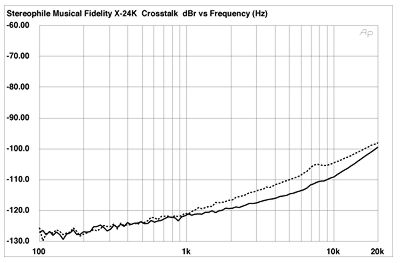
Fig.1 Musical Fidelity X-24K, channel separation at 0dBFS (R-L crosstalk dashed, 10dB/vertical div.).
Its CD-bandwidth frequency responses with and without de-emphasis (top and bottom pairs of traces, respectively) are shown in fig.2. There is a slight droop in the top octave—the response is -0.5dB at 20kHz—which might just be audible with critical material. There is no appreciable error with de-emphasis engaged. Fig.3 compares the analog output responses at 48kHz and 96kHz sample rates. At the higher rate, the rolloff seen in fig.2 continues to -6dB at 40kHz, followed by the sharp rollout of the digital low-pass filter.
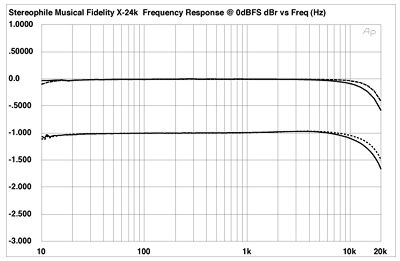
Fig.2 Musical Fidelity X-24K, frequency response (top) and de-emphasis response (bottom). (Right channel dashed, 0.5dB/vertical div.)
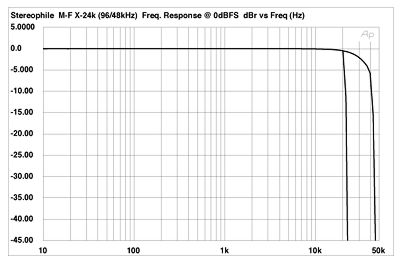
Fig.3 Musical Fidelity X-24K, frequency response at 0dBFS with 48kHz (left) and 96kHz (right) sample rates. (Right channel dashed, 5dB/vertical div.)
A different way of looking at the same information is to compare the waveforms of a 1kHz squarewave sampled at 48kHz (fig.4) and 96kHz (fig.5). The Gibbs Phenomenon "ringing" on the waveform tops can be seen to double with frequency at the higher sample rate, although some leading-edge overshoot is still apparent. (This, I understand, is theoretically inevitable.) But the extra octave of bandwidth available is still not sufficient to allow a DAC to reconstruct a good facsimile of squarewaves much above 1kHz. Fig.6, for example, shows the waveform of a 12kHz squarewave sampled at 96kHz. As a squarewave consists of the fundamental plus a descending series of odd harmonics, this would look like a sinewave at 48kHz sampling. At 96kHz, the third harmonic at 36kHz is now included, but the waveform still doesn't look very square.
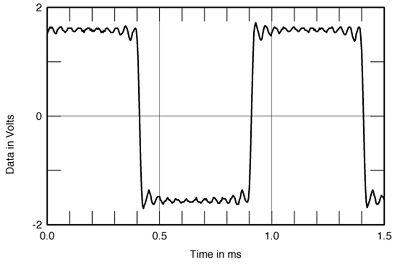
Fig.4 Musical Fidelity X-24K, 1kHz squarewave at 0dBFS, 48kHz sampling.
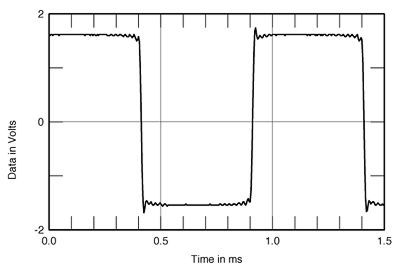
Fig.5 Musical Fidelity X-24K, 1kHz squarewave at 0dBFS, 96kHz sampling.
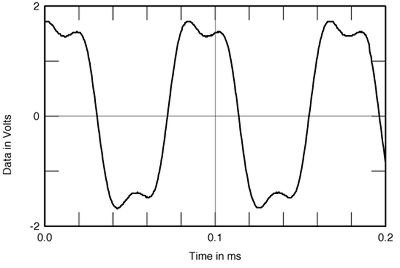
Fig.6 Musical Fidelity X-24K, 12kHz squarewave at 0dBFS, 96kHz sampling.
It's important not to make too much of the extra bandwidth offered by 96kHz sampling. I believe the improvements in sound quality offered by the doubled bandwidth have more to do with the behavior of the digital processing.
Fig.7 shows 1/3-octave spectra taken at the X-24K's analog outputs while it decoded data representing a dithered 1kHz tone at -90dBFS with word lengths of 16 bits (top traces) and 24 bits (bottom). Other than what might be DAC idle tones or spurious noises from the Audio Precision System One at 2kHz and 8kHz, the traces are very clean. The increase in word length drops the noise floor by 10dB or so, implying somewhere between 18- and 19-bit performance. While "24-bit" is proclaimed everywhere with respect to the new generation of processors and DVD players, achieving true 24-bit dynamic range in the analog domain is currently impossible outside of a laboratory. The very best digital playback systems offer around 20-bit noise floors, which is still very much better than 16-bit CD.
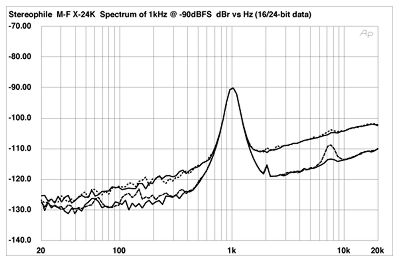
Fig.7 Musical Fidelity X-24K, spectrum of dithered 1kHz tone at -90.31dBFS, with noise and spuriae, 16-bit data (top) and 24-bit data (bottom). (1/3-octave analysis, right channel dashed.)
- Log in or register to post comments




































